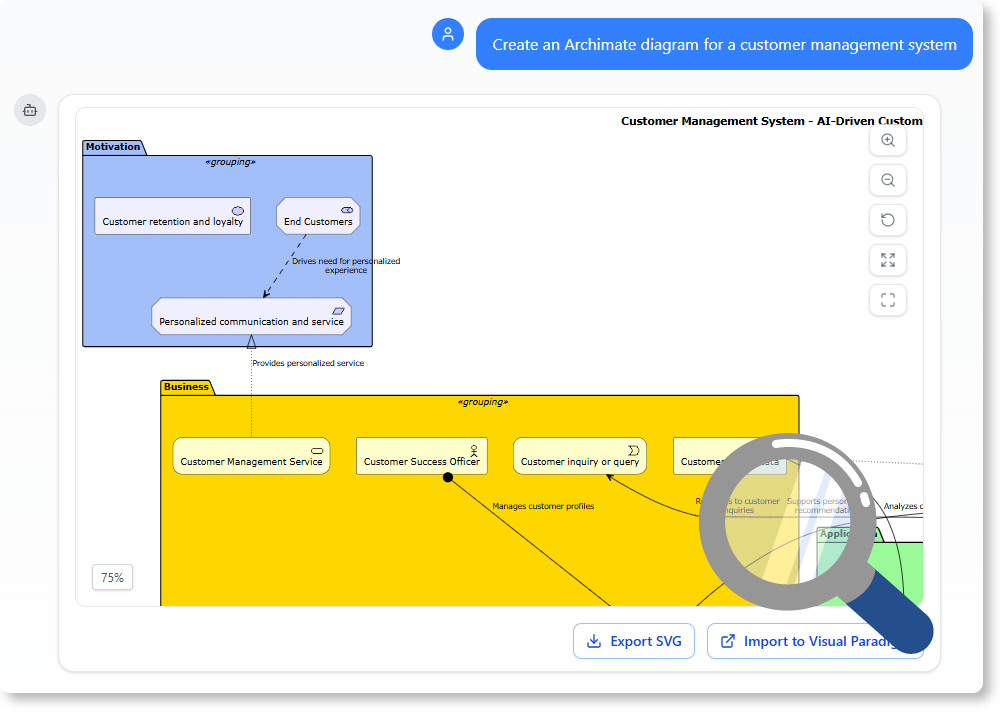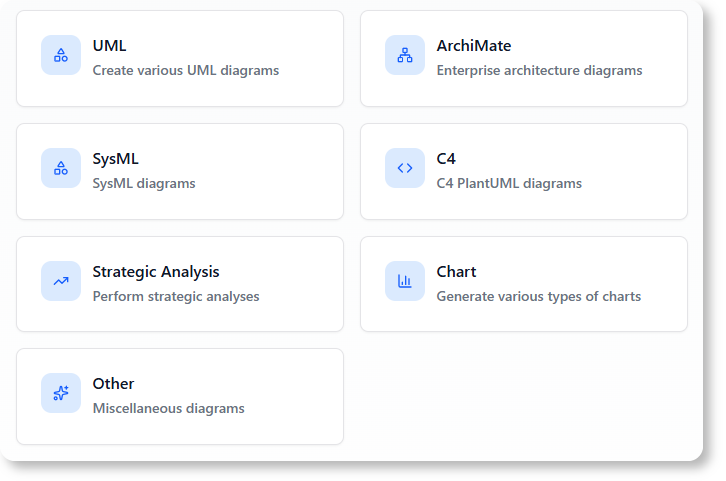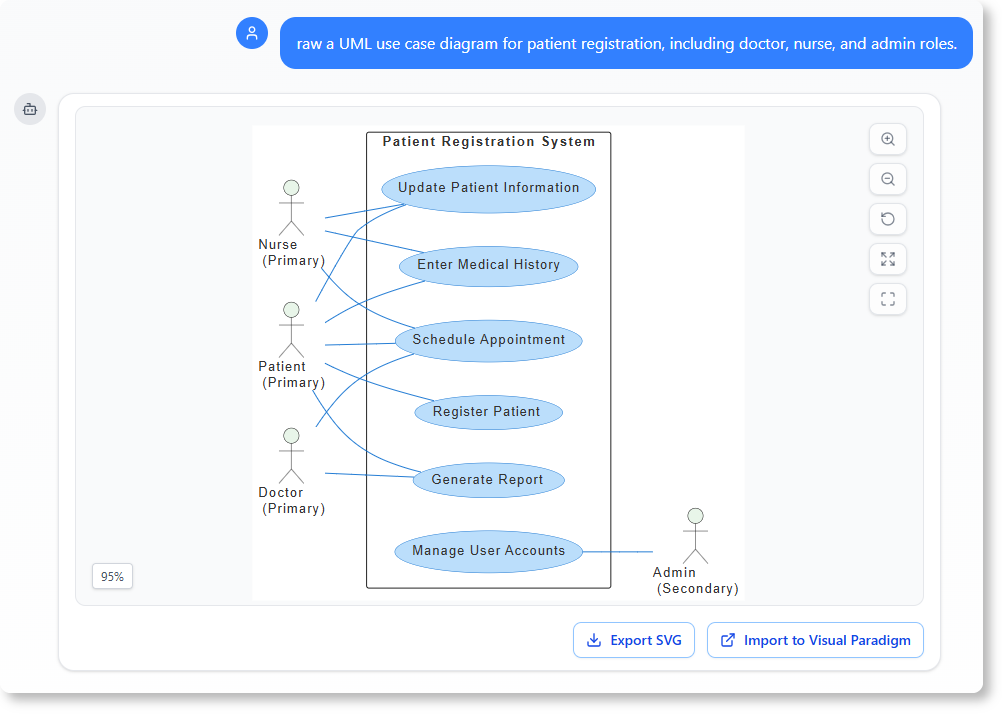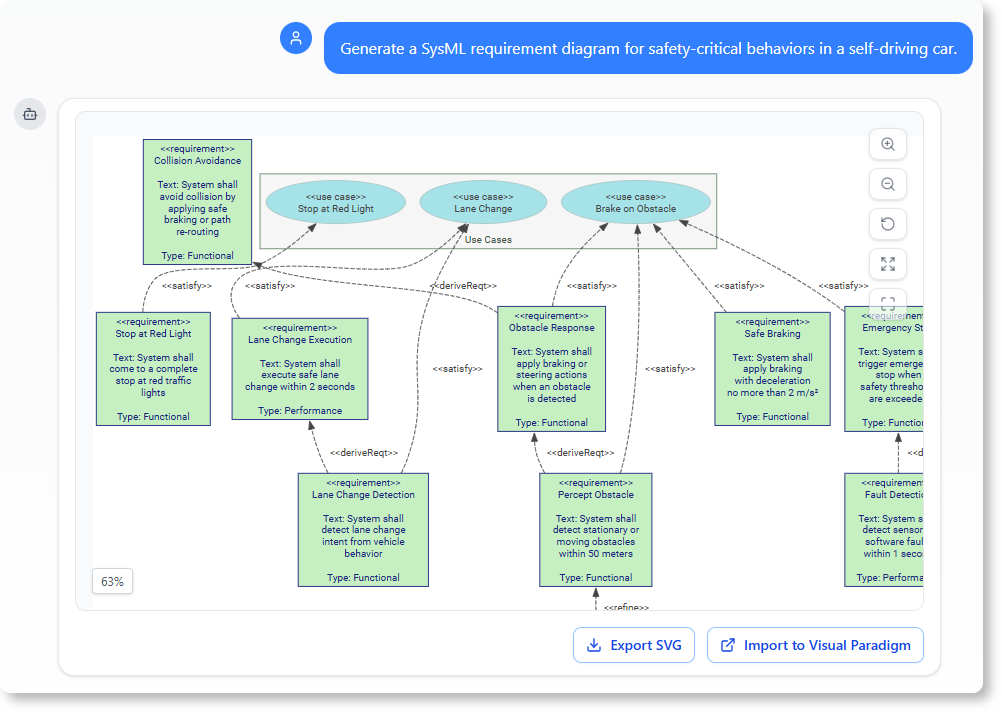What Makes Visual Paradigm’s AI Chatbot Different from Other AI Diagram Tools?
The proliferation of AI-driven diagramming tools has introduced a new layer of automation into software and business analysis. However, most tools remain constrained by narrow domain coverage, generic diagram generation, and isolated functionality. In contrast, the visual paradigm ai chatbot is designed not as a standalone assistant but as a specialized engine for modeling intelligence. It operates within a framework grounded in formal modeling standards, offering a structured, context-aware approach to diagram generation and interpretation.
This distinction stems from its foundation in established modeling languages—UML, SysML, ArchiMate, C4, and business frameworks—each of which has a well-defined syntax, semantics, and use case in systems engineering and strategic analysis. Rather than relying on pattern recognition or statistical modeling, the visual paradigm ai chatbot employs fine-tuned language understanding trained on real-world model instances, enabling it to produce diagrams that adhere to formal specifications and reflect accurate conceptual structures.
Modeling Standards as a Foundational Principle
Unlike general-purpose AI chatbots that generate diagrams based on vague prompts, the visual paradigm ai chatbot is trained on comprehensive modeling standards. Each supported diagram type—such as UML use case, sequence, or state diagrams—follows a strict set of rules defined by the Object Management Group (OMG) or the Institute of Electrical and Electronics Engineers (IEEE). For instance, a UML class diagram must maintain encapsulation, inheritance, and association semantics. The chatbot applies these rules during generation, ensuring that the output is not just visually plausible but conceptually valid.
Similarly, in enterprise architecture, the ArchiMate language defines over 20 viewpoints, including “Business Value” and “Technology Deployment,” allowing for precise layering of domain abstractions. The chatbot’s ability to switch between these viewpoints demonstrates a deeper understanding of architectural modeling than most competitors, which often produce diagrams that lack logical coherence or contextual grounding.

This level of standardization represents a significant advancement over generic ai chatbot for diagrams tools that prioritize output speed over structural fidelity. The ai-powered modeling software in Visual Paradigm does not simply “draw” a diagram—it generates one that aligns with established engineering practices.
Comprehensive Support Across Modeling Domains
The breadth of supported diagram types is not incidental. It reflects a deliberate effort to cover the full spectrum of modeling needs across software development, business strategy, and system design. The tool supports:
- UML: Class, use case, sequence, activity, state, component, deployment, and package diagrams
- SysML: Requirement, block definition, internal block diagram
- ArchiMate: With 20+ standardized viewpoints
- C4 Modeling: System context, container, deployment, and component diagrams
- Business Frameworks: SWOT, PEST, PESTLE, SOAR, Eisenhower Matrix, Ansoff Matrix, Blue Ocean Four Actions
- Data Visualization: Bar, line, area, pie, scatter, radar charts
This coverage enables users to transition seamlessly between technical and strategic modeling—something most ai diagramming tools fail to support. A researcher analyzing a product roadmap, for example, can begin with a SWOT analysis and then transition to a C4 system context to evaluate scalability and dependencies. The tool maintains conceptual continuity through consistent modeling language and structure.

Unified Workspace Integration: A Key Differentiator
A critical advantage lies in the unified workspace ai integration. While many ai-powered tools operate in isolation—sitting in a browser tab or a standalone interface—the visual paradigm ai chatbot remains embedded within the broader Visual Paradigm online environment. This integration allows users to generate diagrams, refine them iteratively, and import them directly into the desktop modeling suite for further analysis.
This continuity supports a workflow where initial ideas emerge from natural language prompts, and subsequent refinement happens within a recognized modeling environment. For instance, a student modeling a healthcare application might begin with: “Draw a UML use case diagram for patient registration, including doctor, nurse, and admin roles.” The chatbot responds with a structured diagram. The user can then refine it—add exceptions, modify actor roles, or link to a deployment diagram—without losing context or structure.

This interoperability offers a level of workflow coherence absent in tools that treat diagram generation as a one-off task. The chatbot vs diagram tools comparison reveals that traditional tools are reactive, while the visual paradigm ai chatbot functions as a proactive, context-preserving assistant.
Contextual Understanding and Post-Generation Intelligence
Beyond diagram generation, the chatbot delivers contextual intelligence. Users can ask follow-up questions such as: “How would you realize this deployment configuration?” or “What are the missing elements in this use case?” The tool responds not with generic advice, but with explanations grounded in modeling theory and practical implementation.
This capability reflects a deeper cognitive layer in the system—one that understands not just what a diagram depicts, but what it implies. For example, in a state machine diagram, the chatbot can infer potential transitions and suggest validation rules based on modeling best practices. This is particularly valuable in academic settings, where students and researchers require not just visual outputs but interpretive analysis.
Additionally, the chatbot supports content translation and provides suggested follow-up queries, reinforcing a dialogue-based workflow rather than a transactional one. These features ensure that users are not left with static outputs but with a living, extensible model.
A Rigorous, Evidence-Based Approach to AI in Modeling
The effectiveness of the visual paradigm ai chatbot is not derived from broad language patterns or superficial pattern matching. Instead, it is rooted in a data-driven training process that draws from real-world model repositories and formal specifications. This ensures that outputs are not only syntactically correct but also semantically meaningful.
In academic modeling, where precision and validity are paramount, such rigor is essential. Competing tools often produce diagrams that are visually appealing but logically inconsistent or contextually irrelevant. The visual paradigm ai chatbot, by contrast, operates under a set of constraints that mirror those found in professional modeling environments.
Practical Application: A Case from Systems Engineering Research

Consider a graduate student working on a thesis about autonomous vehicle control systems. They begin by asking: “Generate a SysML requirement diagram for safety-critical behaviors in a self-driving car.” The chatbot responds with a diagram that includes functional, behavioral, and constraint elements, properly structured and labeled. The student then requests: “Add a failure condition for sensor timeout and link it to the control state.” The chatbot modifies the diagram to incorporate a failure transition, maintaining consistency with SysML rules.
Later, the student inquires: “How does this relate to the C4 system context?” The chatbot generates a system context that maps the vehicle to its environment, showing interaction with infrastructure and human operators. This seamless progression from requirement to context demonstrates the tool’s ability to maintain conceptual continuity across modeling domains.
Conclusion: Beyond Automation—Towards Intelligent Modeling
The visual paradigm ai chatbot stands apart from other ai diagram generator tools not through novelty but through depth. It is not merely an automated sketcher; it is a system that understands modeling standards, supports diverse domains, and integrates into a coherent workflow. Its strength lies in its ability to produce diagrams that are both technically sound and contextually relevant.
For researchers, students, and professionals who demand accuracy and consistency in modeling, this represents a shift from heuristic automation to intelligent, standards-based reasoning. The unified workspace ai integration ensures that the chatbot functions not in isolation, but as a cognitive extension of the modeling process.
In a field where modeling errors can lead to significant misrepresentations, this level of fidelity is not just beneficial—it is essential.
Frequently Asked Questions
Q1: How does the visual paradigm ai chatbot compare to other ai-powered modeling software?
The visual paradigm ai chatbot differs by being trained on formal modeling standards, supporting a wide range of diagram types, and integrating within a unified modeling environment—ensuring consistency and context.
Q2: Can the ai chatbot generate diagrams for complex business frameworks like the Ansoff Matrix?
Yes. The tool supports business frameworks such as SWOT, PEST, and Ansoff Matrix, allowing users to generate structured diagrams that reflect strategic decision points.
Q3: Is the ai-powered modeling software suitable for academic research?
Yes. The tool’s adherence to modeling standards, coupled with contextual explanations, makes it ideal for students and researchers needing precise, interpretable diagrams.
Q4: Does the chatbot support real-time collaboration or file export?
No. The tool does not support real-time collaboration or direct image export. It generates diagrams through natural language prompts and integrates into the Visual Paradigm workspace.
Q5: Where can I access the visual paradigm ai chatbot?
You can access the visual paradigm ai chatbot at chat.visual-paradigm.com. It is designed as an interactive assistant for modeling and analysis.
Q6: How does the chatbot ensure modeling accuracy?
It uses fine-tuned models trained on formal standards, ensuring that generated diagrams follow the rules of UML, SysML, ArchiMate, and other modeling languages.
[For more advanced diagramming capabilities, see the full suite of tools available on the Visual Paradigm website.]
[For immediate access to the ai chatbot for diagrams, visit https://ai-toolbox.visual-paradigm.com/app/chatbot/.]

